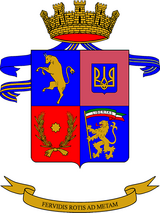
The Lagunari Regiment "Serenissima" is a unit of Italian Army's amphibious Lagunari speciality. The name of the speciality comes from the Italian word for lagoon, while the regiment's name "Serenissima" commemorates the Most Serene Republic of Venice. The regiment is based in Venice and assigned to the Cavalry Brigade "Pozzuolo del Friuli". The "Pozzuolo del Friuli" brigade forms, together with the Italian Navy's Third Naval Division and San Marco Marine Brigade, the Italian Armed Forces' Sea Projection Force.

The 2nd Engineer Regiment is a military engineering regiment of the Italian Army based in Trento in Trentino. The regiment was formed in 1860 and is currently the oldest active engineer regiment of the Italian Army. Since 1954, the unit has been assigned of the 4th Alpine Army Corps and has therefore a strong association with the Italian Army's mountain infantry speciality, the Alpini, with whom the regiment shares the distinctive Cappello Alpino. The regiment is the engineer unit of the Alpine Brigade "Julia" and specializes in mountain combat.

The 32nd Engineer Regiment is a military engineering regiment of the Italian Army based in Fossano in Piedmont. The unit is assigned to the Alpine Brigade "Taurinense" and the army's youngest engineer regiment. On 1 September 2002, the 32nd Engineer Battalion was formed, which, on 24 September 2004, was redesignated XXX Sappers Battalion and then entered the newly formed 32nd Engineer Regiment. The regiment's number was chosen to commemorate the XXXII Sappers Battalion, which fought in the Western Desert campaign of World War II, while the battalion's number commemorates the XXX Sappers Battalion, which fought in the Italian campaign on the Eastern Front. The regiment specializes in mountain warfare and shares with the other units of the Alpine Brigade "Taurinense" the distinctive Cappello Alpino. The regiment's anniversary falls, as for all engineer units, on 24 June 1918, the last day of the Second Battle of the Piave River.

The 57th Infantry Division "Lombardia" was an infantry division of the Royal Italian Army during World War II. The Lombardia was formed on 24 May 1939 in Pula and named for the region of Lombardy. The division was disbanded by the Germans after the Armistice of Cassibile was announced on 8 September 1943.
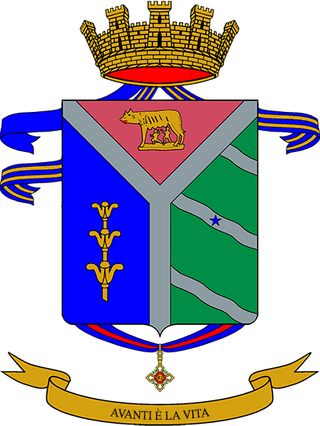
The 8th Paratroopers Engineer Regiment "Folgore" is an airborne military engineering regiment of the Italian Army based in Legnago in Veneto. The regiment is assigned to the Paratroopers Brigade "Folgore" and combines the lineage and traditions of the Royal Italian Army's 8th Engineer Regiment and VIII Paratroopers Sappers Battalion, and the Italian Co-Belligerent Army's CLXXXIV Mixed Engineer Battalion.
The Italian Liberation Corps was a corps of the Italian Co-belligerent Army during the Italian campaign of World War II. After the announcement of the Armistice of Cassibile on 8 September 1943 the Italian government began the formation of units to fight on the allied side against Germany. On 18 April 1944 the Italian Liberation Corps was formed, which after an intense cycle of combat operations was disbanded on 24 September 1944 to form division-sized combat groups.
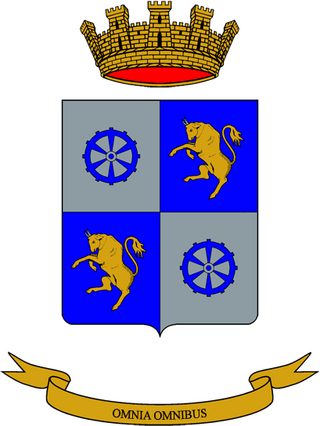
The Logistic Regiment "Taurinense" is a military logistics regiment of the Italian Army based in Rivoli in Piedmont. Originally a transport unit, the regiment is now the logistic unit of the Alpine Brigade "Taurinense" and shares with the brigade's infantry troops, the Alpini, the distinctive Cappello Alpino. The regiment's anniversary falls, as for all units of the Italian Army's Transport and Materiel Corps, on 22 May, the anniversary of the Royal Italian Army's first major use of automobiles to transport reinforcements to the Asiago plateau to counter the Austro-Hungarian Asiago Offensive in May 1916.
With the 1975 reforms the Italian Army abolished the regimental level and replaced it with brigades made up of multiple arms. During the reform the army disbanded 48 regimental commands and reduced its force by 87 battalions. A further ten regimental commands were used to raise ten new brigade commands. Ten training centers, which for traditional reasons had carried the names of regiments, were also disbanded. The reduction in units also allowed to mechanize most of the remaining units in Northern Italy and Italy's defense strategy changed from a hold-at-all-costs territorial defense to one of mobile warfare.

The 21st Engineer Regiment is a military engineering regiment of the Italian Army based in Caserta in Campania. The regiment is the engineer unit of the Bersaglieri Brigade "Garibaldi". The regiment was formed in 1937 and assigned to the XXI Army Corps, which was based in Cyrenaica in eastern Libya. During World War II the regiment formed engineer units for the Italian forces fighting in the Western Desert campaign. After the Axis defeat in the Second Battle of El Alamein and the British conquest of Cyrenaica the regiment was declared lost due to wartime events.

The 11th Engineer Regiment is a military engineering regiment of the Italian Army based in Foggia in Apulia. The regiment is the engineer unit of the Mechanized Brigade "Pinerolo" and was first formed in 1928 by the Royal Italian Army. During World War II the regiment's depot formed engineer battalions and smaller units, which deployed with divisions and corps to the fronts of the war. After the announcement of the Armistice of Cassibile on 8 September 1943 the regiment was disbanded by invading German forces. In 1958, the Engineer Battalion "Ariete" was formed and assigned to the Armored Division "Ariete".

The 10th Engineer Regiment is a military engineering regiment of the Italian Army based in Cremona in Lombardy. The regiment is the engineer unit of the 132nd Armored Brigade "Ariete". In 1926, the Royal Italian Army formed the 10th Engineer Regiment. During the Second Italo-Ethiopian War and during World War II the regiment's depot formed engineer battalions and smaller units, which deployed with divisions and corps to the fronts of the war. After the announcement of the Armistice of Cassibile on 8 September 1943 the regiment was disbanded by invading German forces.

The 5th Engineer Regiment is a military engineering regiment of the Italian Army based in Macomer in Sardinia. The regiment is the engineer unit of the Mechanized Brigade "Sassari". In 1895, the Royal Italian Army formed the 5th Engineer Regiment. During World War I the regiment formed battalions and companies, which operated along the Italian Front. In 1919, the regiment was renamed Miners Engineer Regiment. In 1922, the regiment was disbanded and its companies distributed among the army's ten army corps engineer groupings. In November 1926, the regiment was reformed by renaming the 5th Army Corps Engineer Grouping in Trieste. During the Second Italo-Ethiopian War and World War II the regiment's depot formed engineer battalions and smaller units, which deployed with divisions and corps to the fronts of the war. After the announcement of the Armistice of Cassibile on 8 September 1943 the regiment was disbanded by invading German forces.

The 4th Engineer Regiment is a military engineering regiment of the Italian Army based in Palermo in Sicily. The regiment is the engineer unit of the Mechanized Brigade "Aosta". In 1926, the Royal Italian Army formed the 4th Engineer Regiment in Verona. During the Second Italo-Ethiopian War and World War II the regiment's depot formed engineer battalions and smaller units, which deployed with divisions and corps to the fronts of the war. After the announcement of the Armistice of Cassibile on 8 September 1943 the regiment was disbanded by invading German forces.

The 3rd Engineer Regiment is a military engineering regiment of the Italian Army based in Udine in Friuli-Venezia Giulia. The regiment is the engineer unit of the Cavalry Brigade "Pozzuolo del Friuli". In 1926, the Royal Italian Army formed the 3rd Engineer Regiment in Lodi. During the Second Italo-Ethiopian War and World War II the regiment's depot formed engineer battalions and smaller units, which deployed with divisions and corps to the fronts of the war. After the announcement of the Armistice of Cassibile on 8 September 1943 the regiment was disbanded by invading German forces.

The Engineer Command in Rome-Cecchignola commands the specialized engineer regiments of the Italian Army and it is tasked with training of all officers and troops destined for engineer units, as well as with both doctrinal and operational tasks.
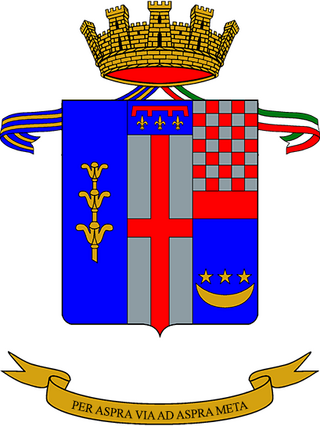
The 6th Pioneer Regiment is a military engineering regiment of the Italian Army based in the Cecchignola quarter of Rome. The regiment is assigned to the army's Engineer Command and the army's sole pioneer unit, whose focus, unlike the army's other engineer units, is on rear area construction tasks. In 1926, the Royal Italian Army formed the 6th Engineer Regiment in Bologna. During World War II the regiment's depot formed engineer battalions and smaller units, which deployed with divisions and corps to the fronts of the war. After the announcement of the Armistice of Cassibile on 8 September 1943 the regiment was disbanded by invading German forces.

The 2nd Pontieri Engineer Regiment is a military engineering regiment of the Italian Army based in Piacenza in the Emilia Romagna. The regiment is assigned to the army's Engineer Command and the Italian Army's only unit focusing on operational level water crossings. The term "Pontieri" comes from the Italian word for bridge and is used to denote units of the Italian Army's engineer arm tasked with the construction and repair of bridges. Enlisted personnel in such units is addressed by the singular form: "Pontiere". The regiment was formed in 1883 as an engineer regiment, which united all Pontieri companies of the Royal Italian Army. During World War I the regiment formed battalions and companies, which operated along the Italian Front. In 1933, the regiment was split into the 1st Pontieri Regiment and 2nd Pontieri Regiment. During World War II the regiment formed battalions and smaller units, which were deployed on all fronts. After the announcement of the Armistice of Cassibile on 8 September 1943, the regiment was disbanded by invading German forces. In 1949, the regiment was reformed and has been active since. The regiment's anniversary falls, as for all engineer units, on 24 June 1918, the last day of the Second Battle of the Piave River.

The 3rd Signal Regiment is a national support signals regiment of the Italian Army based in Rome in Lazio. The regiment is the army's oldest signal regiment and assigned to the army's Signal Command. The regiment's three battalions operate the army's telecommunications network in central Italy and Sardinia. The regiment was formed in 1883 as an engineer regiment, which, in 1895, became responsible for training the Royal Italian Army's telegraph personnel and for providing telegraph units to operational units. In 1912, the regiment added the training of wireless telegraphy personnel to its duties. During World War I the regiment formed a total of 127 companies, 59 of which were transferred in 1918 to the newly formed 7th Engineer Regiment (Telegraphers). In 1920, the regiment was disbanded and its companies formed into battalions, which were assigned to the Royal Italian Army's army corps.

The 7th CIMIC Regiment is a Civil-Military Co-operation regiment of the Italian Army based in Motta di Livenza in Veneto. The regiment is assigned to the Tactical Intelligence Brigade. In 1926, the Royal Italian Army formed the 7th Engineer Regiment in Florence. During the Second Italo-Ethiopian War and World War II the regiment's depot formed engineer battalions and smaller units, which deployed with divisions and corps to the fronts of the war. After the announcement of the Armistice of Cassibile on 8 September 1943 the regiment was disbanded by invading German forces. In 1944, the Italian Co-Belligerent Army formed the CIV Mixed Engineer Battalion for the Combat Group "Mantova", which fought on the allied side in the Italian campaign of World War II.
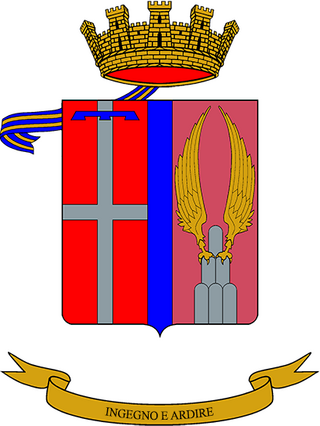
The 1st Engineer Regiment is an inactive military engineering unit of the Italian Army, which was last based in Trento in Trentino. The regiment is the oldest engineer regiment of the Italian Army. In 1848, the Royal Sardinian Army formed the Sappers Regiment, which in 1860 was split into the 1st Sappers Regiment and 2nd Sappers Regiment. Between its formation and 1866, the regiment's companies fought in the First Italian War of Independence, Crimean War, Second Italian War of Independence, Sardinian campaign in central and southern Italy, and the Third Italian War of Independence. In 1867, the two sappers regiments were merged into the Sappers Corps, which, in 1874, was disbanded so the two regiments could be reformed. The 1st Engineer Regiment provided personnel for First Italo-Ethiopian War and two sappers battalions for the Italo-Turkish War. During World War I the regiment's battalions and companies fought in all sectors of the Italian Front, and on the Macedonian Front, Albanian Front, and Western Front. In 1920, the regiment was disbanded. In November 1926, the regiment was reformed and assigned to the I Army Corps. During the Second Italo-Ethiopian War and World War II the regiment's depot formed engineer battalions and smaller units, which deployed with divisions and corps to the fronts of the war. After the announcement of the Armistice of Cassibile on 8 September 1943 the regiment was disbanded by invading German forces.
